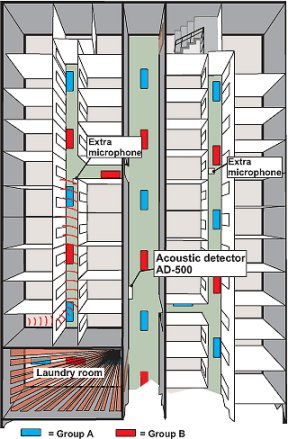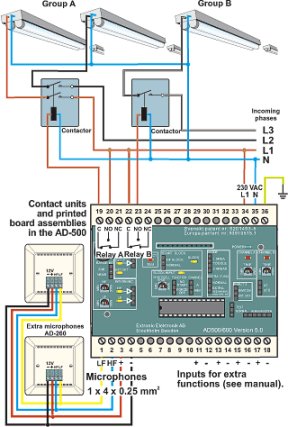7A. Cellar and attic passages with acoustic detectors
50 Hz or non-dimmable HF operating devices
Svenskt patent nr. 9201493-5, English patent No. 0659329
| The premises
Acoustic technology is unbeatable in closed cellar and attic areas, being the only technology that permits activation before entry into the premises. In long conduits and warehouse passages IR detection is often the best detection method (see separate application example). Light sources This application shows an example of fittings with 50 Hz choke operation or non-dimmable HF operating devices. Control system This example shows a conventional installation with an AD-500 acoustic detector and two extra microphones. Note that the cellar stores have ‘mesh walls’. The radius of the microphone range can be 20 – 25 metres, depending on acoustic circumstances. Ceilings provided with acoustic plates can reduce the range of the HF signal. The detector and the microphones must be positioned in the middle of the area of detection. If necessary up to six extra microphones can be connected in parallel, and this connection can use EKKX 1 x 4 x 0.25 mm2. |
Detection in the laundry room, which is noisy, is performed by an IR detector, so that the lighting is switched off during washing when the premises are vacated. The IR detector is connected in a separate system. In this example it is recommended that the load be divided up into two groups of two phases and one phase respectively, controlled by the acoustic detector’s A and B channels. This means that deactivation is gradual. Firstly two phases (Group A) are broken, and if there is no detection within, say, 30 seconds the third phase (Group B) is switched off. If there is someone left in the premises when deactivation of the lighting commences, emission of a sound suffices to switch full lighting back on again. Even if the lighting is completely switched off, it is switched on again as soon as a sound is emitted. Please see the detector manual for adjustment and programming of the acoustic detector. With new or renovated buildings, and if there are a lot of movements in the premises, dimmable fittings and dynamic lighting control can be considered. Please study the separate applications describing dynamic lighting control! Information for current budget
|
||||||||||
 |
 |
||||||||||
 |
|
||||||||||





